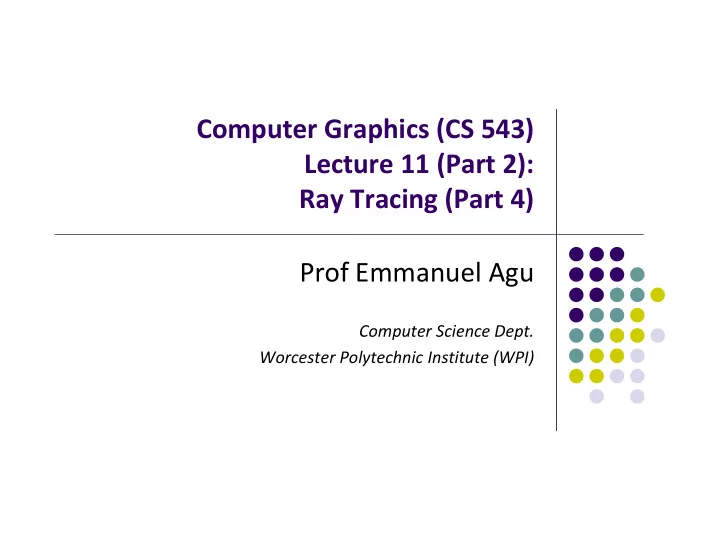

Computer Graphics (CS 543) Lecture 11 (Part 2): Ray Tracing (Part 4) Prof Emmanuel Agu Computer Science Dept. Worcester Polytechnic Institute (WPI)
Reflection and Transparency Ray tracing also handles reflections and refraction of light well We can easily render realistic scenes with mirrors, martini glasses So, far, we have considered Local components (ambient, diffuse, specular) Local components are contributions from light sources which are visible from hit point To render reflection, and refraction we need to add reflection and refraction components of light I I I I I I amb diff spec refl tran
Reflection and Transparency First three components are local I I I I I I amb diff spec refl tran m r dir I I R v s P h I T t Reflected component, I R is along mirror direction from eye –r
Reflection and Transparency r is given as (see eqn 4.22) as r dir dir m m 2 ( ) P’ m Transmitted component I T dir r I I R is along transmitted direction t v Portion of light coming in from s P h direction t is bent along dir I R and I T each have their own I T t five components (ambient, diffuse, etc) In some sense, point P’ along reflected direction r serves as a light source to point P h
Reflection and Transparency To determine reflected component Spawn reflected ray along direction r P’ Determine closest object hit m To determine transmitted component dir r I Cast transmitted ray along I R direction t v s Determine closest object hit P h So, at each hit point, local, reflected I T and refracted components merge to t form total contributions
Reflection and Transparency: Ray Tree Local, reflected, transmitted and shadow rays form a tree
Reflection and Transparency Tree structure suggest recursion at successive hit points Recurse forever? No!! At each point, only fraction of impinging reflected or refracted ray is lost Who determines fraction? Designer… sets transparency or reflectivity in SDL file. E.g reflectivity 0.8 means only 80% of impinging ray is reflected Thus, need to check reflected contribution by saying if (reflectivity > 0.6)… Also check if(transparency > threshold) Basically, do not want to work hard for tiny contributions. Drop (terminate shade) if contribution is too small
Refraction and Transparency May also need to determine how many times you want to bounce (even if threshold is still high) For example, in room with many mirrors, do you want to bounce forever (your system may cry!!) Set recurseLevel (yup!! same as in shadows) to say how many bounces using (variable maxRecursionLevel ) recurseLevel of 4 or 5 is usually enough to create realistic pictures Ray from eye to first hit point has recurseLevel of 0 All rays from first hit point have recurseLevel = 1 Need to modify shade function to handle recursion
Recursive shade( ) skeleton Color3 Scene::shade(Ray& ) { Get the first hit, and build hitInfo h Color3 color.set (the emissive component); color.add( ambient contribution) ; get normalized normal vector m at hit point for (each light source) add the diffuse and specular components // now add the reflected and transmitted components if(r.recurseLevel == maxRecursionLevel) return color; // don’t recurse further
Recursive shade( ) skeleton if (hit object is shiny enough) // add reflected light { get reflection direction build reflected ray, refl refl.recurseLevel = r.recurseLevel + 1; color.add(shininess * shade(refl)); } if( hit object is transparent enough) { get transmitted direction build transmitted ray, trans trans.recurseLevel = r.recurseLevel + 1; color.add(transparency * shade(trans)); } return color; }
Finding Transmitted Direction So far, found reflected direction ray direction as mirror direction from eye Transmitted direction obeys Snell’s law Snell’s law: relationship holds in the following diagram m sin( ) sin( ) 2 1 1 c c 2 1 faster P h slower t 2 c 1 , c 2 are speeds of light in medium 1 and 2
Finding Transmitted Direction If ray goes from faster to slower medium, ray is bent towards normal If ray goes from slower to faster medium, ray is bent away from normal c1/c2 is important. Usually measured for medium ‐ to ‐ vacuum. E.g water to vacuum Some measured relative c1/c2 are: Air: 99.97% Glass: 52.2% to 59% Water: 75.19% Sapphire: 56.50% Diamond: 41.33%
Critical Angle There exists transmitted angle at which ray in faster medium (e.g. air) is bent along object surface That angle ( 2 in figure below) is known as the critical angle Increasing transmission angle beyond critical angle has “no effect”… transmitted ray still below object surface Physical significance: m Underwater in pond, can see enter world through small 1 cone of angles faster P h slower t 2
Transmission Angle Vector for transmission angle can be found as c c 2 2 t dir ( m dir ) cos( ) m 2 c c 1 1 where m dir 1 c m 2 2 cos( ) 1 1 ( dir ) c1 2 c Medium #1 1 P h c2 Medium #2 t 2
For Project 5 May read up hit (intersection) functions for meshes Add to your ray tracer
References Hill and Kelley, Computer Graphics using OpenGL, 3 rd edition, Chapter 12
Recommend
More recommend